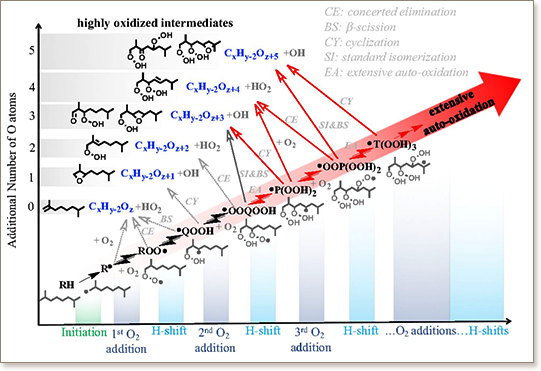Unraveling the structure and chemical mechanisms of highly oxygenated intermediates in oxidation of organic compounds


Decades of research on the autooxidation of organic compounds have provided fundamental and practical insights into these processes; however, the structure of many key autooxidation intermediates and the reactions leading to their formation still remain unclear. This work provides additional experimental evidence that highly oxygenated intermediates with one or more hydroperoxy groups are prevalent in the autooxidation of various oxygenated (e.g., alcohol, aldehyde, keto compounds, ether, and ester) and nonoxygenated (e.g., normal alkane, branched alkane, and cycloalkane) organic compounds. These findings improve our understanding of autooxidation reaction mechanisms that are routinely used to predict fuel ignition and oxidative stability of liquid hydrocarbons, while also providing insights relevant to the formation mechanisms of tropospheric aerosol building blocks. The direct observation of highly oxygenated intermediates for the autooxidation of alkanes at 500–600 K builds upon prior observations made in atmospheric conditions for the autooxidation of terpenes and other unsaturated hydrocarbons; it shows that highly oxygenated intermediates are stable at conditions above room temperature. These results further reveal that highly oxygenated intermediates are not only accessible by chemical activation but also by thermal activation. Theoretical calculations on H-atom migration reactions are presented to rationalize the relationship between the organic compound’s molecular structure (n-alkane, branched alkane, and cycloalkane) and its propensity to produce highly oxygenated intermediates via extensive autooxidation of hydroperoxyalkylperoxy radicals. Finally, detailed chemical kinetic simulations demonstrate the influence of these additional reaction pathways on the ignition of practical fuels.
DOI: 10.1073/pnas.1707564114/-/DCSupplemental

"KAUST shall be a beacon for peace, hope and reconciliation, and shall serve the people of the Kingdom and the world."
King Abdullah bin Abdulaziz Al Saud, 1924 – 2015
Thuwal 23955-6900, Kingdom of Saudi Arabia
© King Abdullah University of Science and Technology. All rights reserved